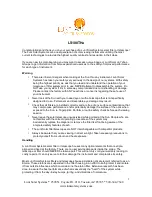
14
Fig. 20a & 20b
: Jupiter: Examples
of the right amount of
magnification and too much mag-
nification.
Fig. 19
: Meade Super
Plössl eyepieces.
Too Much Power?
Can you ever have too much power? If the type of power you’re referring to is
eyepiece magnification, yes, you can! The most common mistake of the
beginning observer is to “overpower” a telescope by using high magnifications
which the telescope and atmospheric conditions cannot reasonably support.
Keep in mind that a smaller, but bright and well-resolved image is far superior to
one that is larger, but dim and poorly resolved (see Figs. 20a and 20b). Powers
above 300X should be employed only under the steadiest atmospheric
conditions.
AutoStar can calculate the best eyepiece for you to use. Try out the “Eyepiece
Calc” feature in the Utilities menu.
Most observers should have three or four additional eyepieces to achieve the full
range of reasonable magnifications possible with the
ETX
telescopes. See
OPTIONAL ACCESSORIES
, page 42.
ETX TIPS
possible, in the SP 26mm eyepiece's field of view. Tighten the vertical and
horizontal locks (6 and 9, Fig. 1) so that the tube cannot move and the object
remains centered.
2. While looking through the SmartFinder, turn the top or side alignment screws (13
and 14, Fig. 18), until the red dot of the SmartFinder points at precisely the same
position as the view through the eyepiece of the main telescope.
The SmartFinder is now aligned to the main telescope. Unless the alignment screws
are disturbed or the LNT Module is moved out of place, the SmartFinder should
remain aligned indefinitely. NOTE: You may want to refine the SmartFinder alignment
by performing this procedure on a bright star.
Choosing an Eyepiece
The magnification or power, at which a telescope is operating is determined by two
factors: the
focal length of the telescope and the focal length of the eyepiece.
Telescope Focal Length is the distance that light travels inside the telescope before
reaching a focus. In the mirror-lens design of the ETX models, the focal length is
compressed by the telescope’s secondary mirror, so that a long focal length is housed
in the short ETX optical tube. For example, the ETX-90PE’s focal length is 1250mm
or about 49”. This means that if the ETX–90PE were a classical refracting-type of
telescope, the optical tube would be more than four feet long instead of the
ETX–90PE's compact 11” tube length.
Eyepiece Focal Length is the distance light travels inside the eyepiece before
reaching focus. Focal length is usually printed on the side of the eyepiece,
for example,
26mm. Low-power eyepieces are typically available in 26mm, 32mm and 40mm sizes
(see
OPTIONAL ACCESSORIES
, page 42). The low-power eyepiece provided with your
ETX is designed to provide a wide, comfortable field of view with high image resolution.
Calculating Magnification: On a telescope, such as the ETX, different eyepiece
focal lengths are used to achieve different magnifications, from low to high. A 26mm
eyepiece yields 48X (“48-power”) on the ETX-90PE and 73X on the ETX-125PE. A
variety of powers may be obtained with the addition of optional eyepieces as well as
the #126 2X Barlow Lens which doubles the power of an eyepiece (see
OPTIONAL
ACCESSORIES
, page 42). To calculate magnification, divide the focal length of the
telescope’s optical tube by the focal length of the eyepiece. For example ETX125PE:
Telescope Focal Length divided by Eyepiece Focal Length
= Power
1900mm divided by 26mm
= 73X
With Barlow: 73 x 2
= 146X
The eyepiece power or magnification is therefore 73X and 146X with the Barlow.
Most observers should have 3 or 4 eyepieces plus the #126 2X Barlow to achieve the
full range of reasonable magnifications possible with ETX models.
Fig. 18
: Turn the top (13) or
side (14) Smartfinder
adjustment screws.
Ti p
: If you plan on
viewing using higher
magnification eyepieces,
first locate, center and
focus the object using a
low-power eyepiece
(e.g., 26mm eyepiece).
Then remove the low-
power eyepiece and
replace it with a higher-
power eyepiece; the
object should still be
centered in the field of
view. Objects are much
easier to locate and cen-
ter at lower powers;
higher powers are
employed simply by
changing eyepieces.
Adjustment screws
Premium ETX_without 105.qxd 1/27/09 12:33 PM Page 14
Summary of Contents for ETX series AutoStar
Page 1: ...Instruction Manual ETX Premier Edition Telescope Series AutoStar LNT SmartFinder ...
Page 2: ......
Page 59: ......








































